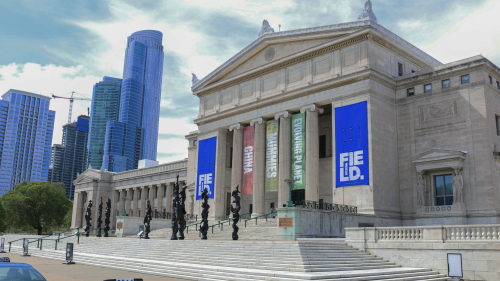As Museums Around the World Grapple with Repatriation, Where Does Chicago Stand?

Issues around object provenance have hit the museum industry hard. Here’s a list of Illinois institutions that have dealt with controversies in this arena.
Museums, universities, and other cultural institutions are reckoning with the items in their collections now more than ever. Many are returning items that were stolen and looted, but others are engaging in lengthy court battles to prove their ownership is legal. In the most morbid cases, the disputes concern human remains once cataloged in the interest of anthropology.
Chicago has not been immune to this focus on provenance — the history of a piece’s ownership — and repatriation, the practice of returning pieces to their home countries. The Art Institute is currently in a legal battle over a drawing allegedly stolen by Nazis, and the Field Museum has been reckoning with its handling of Native American artifacts and remains for years.
Patty Gerstenblith, a law professor at DePaul University and director of its Center for Art, Museum and Cultural Heritage Law, told ChicagoGlobal that interest in museum provenance began ticking upwards in the 1990s, with a “rediscovery” of the extent of Nazi looting during World War II. Now attention is turning to pieces taken by colonial powers during the 19th and early 20th centuries.
“I don’t necessarily see a watershed moment,” Gerstenblith said of the increased interest. But she says that people do want to know: “What are in the museum collections? How did they get there?”
As interest in these questions steadily grows, here are four institutions in Illinois that have dealt with provenance issues.
Art Institute of Chicago
Founded in 1879, the Art Institute has been at the center of multiple provenance controversies. One of the most recent involves a drawing by 20th-century Austrian painter Egon Schiele, which is alleged to have been looted by Nazis from the collection of an art patron who died in the Holocaust. The Art Institute is currently locked in a legal battle over its ownership of the piece. The museum says the drawing only ever changed hands by lawful means, writing in a court filing this spring, “There is no evidence at all – none – that the Work was ever physically seized by the Nazis.”

Though the Art Institute has not returned its Egon Schiele work to the family that claims it was stolen from their ancestor, the Schiele drawings pictured here were returned to the family from other museums in 2023. (Photo: Bobby Caina Calvan / AP)
This isn’t the first time the museum has been embroiled in controversy over works allegedly looted by Nazis. In the 1990s, an Edgar Degas painting put the museum in hot water when three heirs to Holocaust victims Friedrich and Louise Gutmann argued that it had belonged to the Gutmanns and been stolen by a Nazi-aligned dealer.
The museum’s Alsdorf Galleries have also come under scrutiny due to the murky provenance of some of their pieces, particularly those from Nepal. Some other museums, including New York’s Metropolitan Museum of Art, have cooperated with efforts to repatriate potentially looted Nepalese works. But the Art Institute has so far refused to hand over artifacts like a gilt-copper necklace, despite an inscription on the necklace with the name of the temple it was allegedly looted from. In a statement to ChicagoGlobal, the Art Institute made the following note about that case: “We sent a letter in May 2022 requesting that the government of Nepal provide us with additional information on the Taleju necklace, and are still awaiting a response. We are open to learning about any additional information the government has to share on this matter.”
Gerstenblith said that, sometimes, a “rescue narrative” — the idea that Western institutions can take better care of artifacts than other countries’ — could be a reason that museums refuse to give back artifacts.
“In this case, [the necklace] is so clearly marked where it came from,” she said. “...Why aren’t they giving it back? Are they being subconsciously influenced by this idea, that rescue narrative, that this is the better place for it to be, more people will see it here? I don’t know, one might speculate.”
The Art Institute has also been connected to Subhash Kapoor, a New York-based art dealer who trafficked in stolen antiquities from India and Southeast Asia for decades.
On the other hand, though, the Art Institute announced last summer it was sending back a 12th-century Thai artifact back to its place of origin.
Further, the museum formally established a provenance team in 2020 and recently appointed Jacques Schuhmacher, who did provenance research for the Victoria and Albert Museum in London, as the team’s executive director. His work in London resulted in the repatriation of several artifacts.
In a statement to ChicagoGlobal, the Art Institute expanded on its provenance research work. “Provenance research has been an institutional focus for decades, but that work has evolved significantly over time,” the statement read. “In recent years, we have prioritized a systematic review of all the works in our permanent collection and in support of these efforts, we have grown our provenance team to include five dedicated roles to provenance research, which is one of the largest provenance teams of any museum in the country.”
Gerstenblith said that, once museums hire a provenance team, the key question is what they do with the information that provenance research reveals.
“There’s a lot of judgment that needs to be brought to bear to essentially interpret provenance information,” she said. This raises the question of who the provenance team reports to — a curator, whose job is to acquire things for the museum, versus a legal team or board.
Field Museum
One of the Field Museum’s biggest controversies has been its collection of about 4,500 human remains, many of which were unethically looted from Indigenous communities. A key segment of the museum’s founding collection was made up of remains of people from the Hopewell culture, a network of Native Americans from before European contact; they were acquired in an excavation that “self-taught archaeologist” Warren K. Moorehead led for the 1893 World’s Columbian Exposition in Chicago.
The Native American Graves Protection and Repatriation Act (NAGPRA) has required since 1990 that any institutions receiving federal funds must repatriate Native American remains and cultural items. According to ProPublica, though, the Field Museum had returned legal control of only about 512 Indigenous remains to their tribes by the end of 2022 — just 28% of the 1,830 Native American remains it reported to the National Park Service.
Another controversy involves the so-called Benin bronzes. In 1897, British troops stole up to 10,000 artifacts from the Kingdom of Benin’s royal palace (located in present-day Nigeria). Those items eventually ended up in museums across the world, and in recent years, the effort to repatriate them has been one of the highest-profile provenance stories of the art world. Some museums have returned the Benin bronzes once held in their collections, but the Field Museum — like the British Museum, which has been at the center of the controversy — has yet to do so. According to an online database, the Field Museum has 393 Benin artifacts in its possession.
University of Chicago
In 1937, the University of Chicago’s Institute for the Study of Ancient Cultures — called the Oriental Institute at the time — received around 30,000 clay tablets and fragments on loan from Iran. These tablets, called the Persepolis Collection, revealed details about life in the Persian Empire.
Many of the tablets were returned in the decades that followed, but further return efforts were put on hold after a Hamas attack injured several Americans in Jerusalem in 1997. Because Iran supported Hamas, a U.S. court ruled that the Iranian government owed the victims $71.5 million — a sum that the survivors felt could be chipped away at by selling off the remaining Persepolis artifacts. In 2018, the Supreme Court finally ruled that such seizure and sale of the objects was not permissible, freeing the University of Chicago and the U.S. government to resume the work of returning the items.
The latest return happened in September, when the U.S. gave 1,100 tablets back to Iran.
This decades-long process certainly mired the university in some controversy, with observers in the Middle East especially calling the items’ return a matter of repatriation. University leaders, however, dispute that claim, since the college never claimed ownership of the collection.
Illinois State Museum
Like the Field Museum, the Springfield-based Illinois State Museum is another institution that still holds thousands of Native American remains. The museum’s Fulton County branch, called the Dickson Mounds Museum, has proven especially controversial. The museum consists of an Indigenous burial site that a chiropractor named Don Dickson dug open in the 1920s and turned into a roadside attraction. The state of Illinois bought the land in 1945 and eventually converted it into a museum.
Until the 1990s, the museum allowed visitors to peer directly into the burial site at the exposed remains of Indigenous people. The passage of NAGPRA prompted the state museum system to close up that part of the facility, but it has not cut ties with the site. Overall, the Illinois State Museum system still holds at least 7,000 Indigenous human remains and has only returned 2% of them in the last 30 years, according to ProPublica.
That said, the museum has been repatriating other items from its collection. In 2019, it returned 42 artifacts to Indigenous Australian tribes, and last year, it returned over 30 artifacts to Kenya that had been stolen from Mijikenda villages in the 1980s.
Editor's Note (Nov. 5): This story has been updated to include statements from the Art Institute of Chicago.
This story first appeared in the ChicagoGlobal newsletter, a joint project of Crain's Chicago Business and the Chicago Council on Global Affairs.

